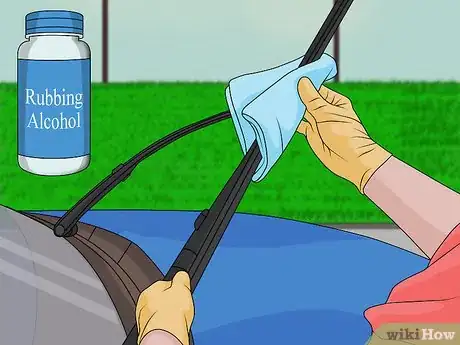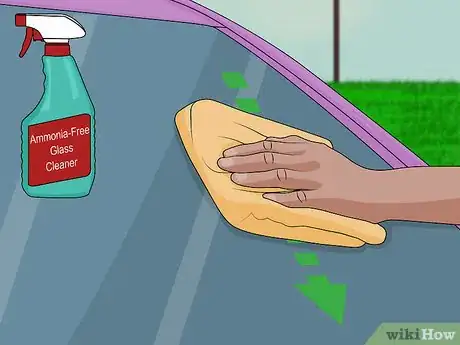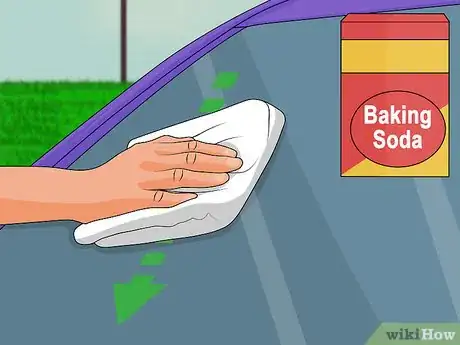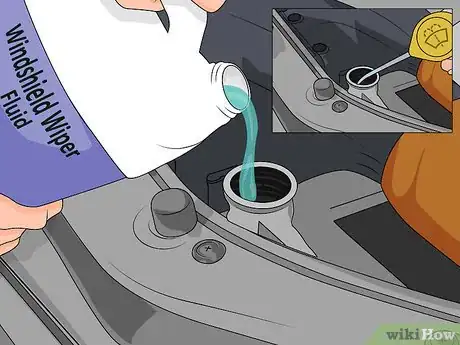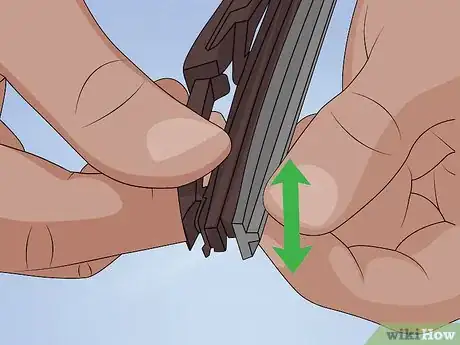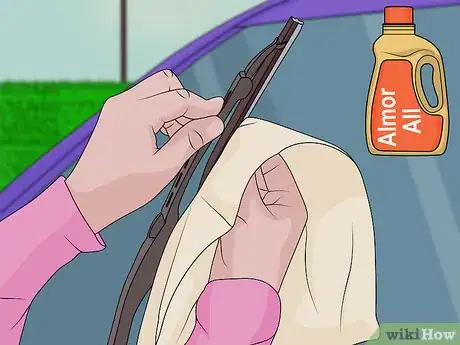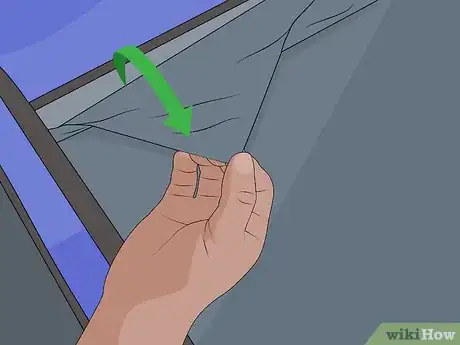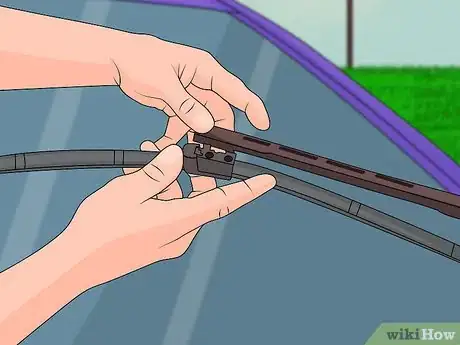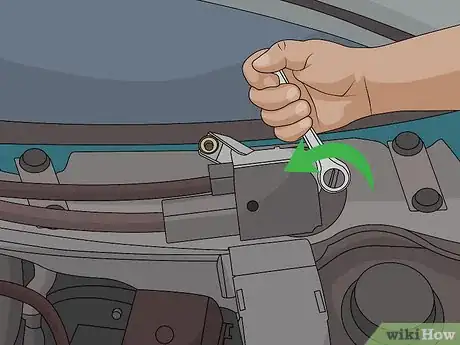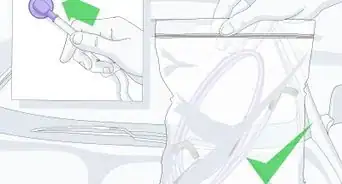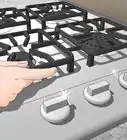This article was co-authored by Mike Parra. Mike Parra is a Master Mechanic in Arizona. With over 20 years of mechanic experience, he has experience working with American, European, and other foreign makes and models. He is ASE (Automotive Service Excellence) certified and has an AA degree in Automotive Repair Technology.
There are 7 references cited in this article, which can be found at the bottom of the page.
wikiHow marks an article as reader-approved once it receives enough positive feedback. This article received 11 testimonials and 87% of readers who voted found it helpful, earning it our reader-approved status.
This article has been viewed 1,173,021 times.
The piercing shriek of your windshield wipers can make every rainstorm a painful experience. Most often, squeaking is caused by a dirty windshield or wiper blades, so you may need to give these a thorough cleaning. If that doesn't work, try resolving common causes of squeaking, like stiff rubber and loose fasteners. However, if your blades are warped, falling apart, or brittle, they'll probably need to be replaced.
Steps
Cleaning the Windshield and Blades
-
1Remove buildup from wiper blades. Lift the wiper blade so it is oriented away from the windshield. Wet a piece of paper towel with a small amount of hot, soapy water or rubbing alcohol. Wipe the blades with the towel until the paper towel comes away clean.
- Remember to clean the arm and hinged parts as well. Hinged parts of the wiper assembly can stiffen with dirt and grime, contributing to squeakiness.
- For severely dirty wipers, you may need to use several pieces of paper towel. If your paper towel is somewhat flimsy, double it up before wiping or use a rag.
- If your wiper blades don't stay in position when pulled away from the windshield, hold the blade away from the glass with your free hand and clean them one at a time.[1]
-
2Clean the windshield glass thoroughly with glass cleaner. Coat your windshield with a generous amount of ammonia-free glass cleaner. Now you’re ready to wipe the windshield clean with a soft, lint-free cloth, like one made from microfiber. Wipe with a top-to-bottom motion until the glass is clean.
- Undiluted white vinegar can be substituted for glass cleaner. Add it to a spray bottle and use it as you would glass cleaner. Avoid getting vinegar on painted areas of your car.[2]
- Ammonia based cleaners can damage tinting and cause plastic to degrade quickly. Ammonia-free glass cleaners should be clearly indicated on their label.[3]
Advertisement -
3Clean a very dirty windshield with baking soda. Simply sprinkle a generous amount of baking soda on a water dampened paper towel for a stronger cleaning. Then wipe the glass clean in a top-to-bottom motion.[4]
-
4Remedy squeaking on-the-go with alcohol wipes. If squeaking starts suddenly when you’re on the road, you won’t have the luxury of having household supplies on hand. Instead, keep some alcohol wipes in your car. When squeaking occurs, wipe the rubber of both blades with the alcohol wipe.[5]
Resolving Common Causes of Squeaking
-
1Refill your windshield wiper fluid. Lots of wipers skip and squeak because the windshield isn't quite wet enough. Check your fluid level and top it off when necessary. This way, your sprayers are ready for action if squeaking occurs.[6]
-
2Adjust the position of the wiper blades when necessary. Windshield wipers are designed to follow behind the motion of the wiper arm. If your blades are stiff and don’t trail behind the arm in a back-and-forth motion, twist the arm with your hands to loosen the stiffness.
- Blades that are too tight won’t be able to alternate back and forth to trail behind the wiper arm smoothly, which causes chattering and squeaking.
- Wiper blades should never appear to "dig" into the windshield or remain vertical as they sweep across the windshield.[7]
-
3Soften your windshield wipers. Stiff wiper blades can also cause chattering and squeaking. Some blades may be stiff fresh from the box, others may become stiffen through exposure to the elements. Blades that are a year old should be replaced; blades that are newer can be softened with:
- ArmorAll. Apply a liberal amount of ArmorAll to a piece of paper towel. Using circular motions, work the ArmorAll into the rubber of the blade to soften it.[8]
- Rubbing alcohol. Dampen a paper towel with rubbing alcohol. Gently buff the rubber of the blade with the rubbing alcohol dampened towel.
- WD-40. Use this technique sparingly, as too much WD-40 can dry out rubber. Spray a little WD-40 on a paper towel, lightly apply it to the rubber of the blade, then wipe it dry.[9]
-
4Adjust the tightness of fasteners. Check to see if your blades or the wiper assemblies under them are too loose or too tight. Too little or too much tension between the glass and wiper can create chattering or squeaking, too.
- Generally, fasteners can be tightened with a wrench by turning them clockwise and loosened by turning them counterclockwise.[10]
- You may need to experiment with the tightness to find what works best. Ideally, the blades should be held firmly in place, but should still be loose enough to sweep back-and-forth across the windshield.
-
5Remove friction increasing films. Common automotive surface protectants, like Rain-X or certain kinds of wax, can cause chatter or squeaking. Remove the product an eliminate obnoxious wiper noises with an application of normal car polish.
- The film left behind by certain automotive surface products can increase the friction between the wiper blades and the windshield, creating unpleasant noises, like squeaking.[11]
Replacing Wiper Parts
-
1Install new rubber inserts. If the non-rubber blade and arm parts are still in good condition, it goes without saying you won’t need to replace them. But sometimes the rubber breaks down faster than non-rubber parts (especially in sunny areas). Remove and replace the rubber blade inserts.[12]
-
2Replace your wiper blades regularly. Pull the metal arm away from the windshield. Where the blade attaches to the arm, you should see a joint. On this you’ll find a release for the arm. Open the release, take out the old blade, insert a new one, and reset the release.[13]
- On some cars, there may be a push-tab or tension hook attaching the blades to the arm assembly. Release these kinds of fasteners with your hands and slide off the blade.
- Depending on who you ask, you might hear that you should change your blades every six months or once a year, but it’s always a good idea to before the rainy season.
-
3Replace the wiper assembly. Follow the wiper blade down the arm to its base. You should see a nut sticking up from this point. Remove the nut with a wrench. Now you can pull the arm off. Fit a replacement arm into place and fasten the nut and your new assembly is good to go.[14]
- With time and use, the assemblies holding your wiper blades in place can become misshapen or inflexible, contributing to squeaking.
Warnings
- Never add dishwashing detergent to your washer fluid. This could cause your windshield to become even squeakier.⧼thumbs_response⧽
- Foreign buildup, like dirt, can cause squeakiness when splashed onto your car. Avoid making (or getting) a big splash when it rains.⧼thumbs_response⧽
- When replacing your blades, it may take some trial and error. Different car models will require different size and style wipers.⧼thumbs_response⧽
- Don’t use wipers when the windshield is frosty. This can cause above average wear or even tears in the wipers.⧼thumbs_response⧽
- Never wax your windshield as this could make the glass and blades very slippery and prevent you from seeing in severe weather conditions.⧼thumbs_response⧽
Things You’ll Need
- Microfiber cloths (several)
- Replacement rubber inserts (x2)
- Replacement wiper assembly (x2)
- Replacement wiper blades (x2)
- Rubbing alcohol
- Spray bottle(s)
- Vinegar
- WD-40
- Wrench (optional)
References
- ↑ https://www.yourmechanic.com/article/how-to-clean-windshield-wiper-blades
- ↑ https://www.driving.co.uk/car-clinic/car-clinic-will-vinegar-stop-windscreen-wipers-screeching/
- ↑ http://www.autogeek.net/waterspots.html
- ↑ https://www.windshieldguide.com/best-practices-to-stop-squeaking-of-windshield-wiper-blades/
- ↑ https://www.windshieldguide.com/best-practices-to-stop-squeaking-of-windshield-wiper-blades/
- ↑ https://www.windshieldguide.com/best-practices-to-stop-squeaking-of-windshield-wiper-blades/
- ↑ https://www.windshieldguide.com/best-practices-to-stop-squeaking-of-windshield-wiper-blades/
- ↑ http://www.sparxeng.com/blog/chemical/better-living-chemistry-windshield-wipers
- ↑ https://www.windshieldguide.com/best-practices-to-stop-squeaking-of-windshield-wiper-blades/
- ↑ https://books.google.com/books?id=n88DAAAAMBAJ&pg=PA198&lpg=PA198&dq=anything+auto+how+to+remove+clip+on+windshield+wiper+arm&source=bl&ots=bLLOq_d9h9&sig=nHfdZW9dYVVBnVB_SfZquJ6uo2o&hl=en&sa=X&ved=0ahUKEwj37NC-r_vKAhWLuoMKHfq2BpkQ6AEIQDAH#v=onepage&q=anything%20auto%20how%20to%20remove%20clip%20on%20windshield%20wiper%20arm&f=false
- ↑ https://www.windshieldguide.com/best-practices-to-stop-squeaking-of-windshield-wiper-blades/
- ↑ https://books.google.com/books?id=n88DAAAAMBAJ&pg=PA198&lpg=PA198&dq=anything+auto+how+to+remove+clip+on+windshield+wiper+arm&source=bl&ots=bLLOq_d9h9&sig=nHfdZW9dYVVBnVB_SfZquJ6uo2o&hl=en&sa=X&ved=0ahUKEwj37NC-r_vKAhWLuoMKHfq2BpkQ6AEIQDAH#v=onepage&q=anything%20auto%20how%20to%20remove%20clip%20on%20windshield%20wiper%20arm&f=false
- ↑ https://books.google.com/books?id=n88DAAAAMBAJ&pg=PA198&lpg=PA198&dq=anything+auto+how+to+remove+clip+on+windshield+wiper+arm&source=bl&ots=bLLOq_d9h9&sig=nHfdZW9dYVVBnVB_SfZquJ6uo2o&hl=en&sa=X&ved=0ahUKEwj37NC-r_vKAhWLuoMKHfq2BpkQ6AEIQDAH#v=onepage&q=anything%20auto%20how%20to%20remove%20clip%20on%20windshield%20wiper%20arm&f=false
- ↑ https://www.familyhandyman.com/automotive/car-maintenance/windshield-wiper-arm-replacement/view-all
About This Article
To stop your windshield wiper blades from squeaking, try wiping down the blades with hot, soapy water or rubbing alcohol and see if that fixes the problem. If that doesn't work, try twisting the windshield wiper arms so they're not as stiff since stiff blades can cause squeaking and chattering. You can also rub some ArmorAll or WD-40 on the blades to soften them so they're not as squeaky. Also, if the fasteners holding your windshield wipers are too loose or tight, adjust them with a wrench and see if that helps. To learn how to replace squeaky windshield wipers, scroll down!
